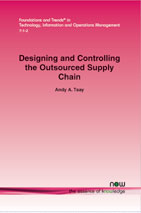Designing and Controlling the Outsourced Supply Chain
By Andy A. Tsay, Leavey School of Business, Santa Clara University, USA, atsay@scu.edu
Abstract
All organizations outsource. They differ only in the scope and extent of what they procure as goods and services from outside entities. These choices drive an organization's financial performance and long-term competitive viability, and establish the tenor of day-to-day operations. Outsourcing can solve many problems, but is also fraught with hidden costs and risks.
This monograph examines outsourcing from a lifecycle perspective. This means tracing the full arc from the germination of the idea to outsource, to the assessment of options, to the installation of control mechanisms, to grappling with conflicts that inevitably arise over time, all the way to the sunset of the chosen strategy. The analysis is highly attentive to the details of operational execution, especially regarding how human resources participate in these decision processes and are impacted by the choices made.
The lifecycle discussion applies regardless of the type of business process considered for outsourcing. This has standalone value, but also serves as a preamble to the topic from which this monograph derives its title: outsourcing in the endeavor of stewarding a product from concept to market and then operating the resulting supply chain. Specifically, this monograph looks deeply at the outsourcing of manufacturing, product design, materials procurement, and logistics.
This monograph also presents the phenomenon of offshoring in order to dispel the common confusion between outsourcing and offshoring. Both can be pursued simultaneously ("offshore outsourcing"), and this monograph makes clear which benefits and risks are due to offshoring and which are due to outsourcing.
This monograph targets scholars and practitioners at once, guided by a belief that both communities will benefit from a treatment of outsourcing that ties together ideas from theory and extensive industrial evidence. Highlights include extended case studies featuring Amazon, Apple, Boeing, Cisco, Foxconn, Menu Foods, Nike, and Toysrus.com, with significant supporting appearances by more than fifty other firms from diverse industries and countries.
Designing and Controlling the Outsourced Supply Chain
Designing and Controlling the Outsourced Supply Chain takes an in-depth look at the role of outsourcing in taking a product from concept to market and then operating the resulting supply chain. This means examining the outsourcing of manufacturing, product design, materials procurement, and logistics. By presenting, interpreting, and extending the current knowledge, the author's prevailing goal is to shed light on the underlying economic and behavioral drivers, implementation challenges, and potential remedies. The analysis is highly attentive to the details of operational execution, particularly regarding how human resources take part in these decision processes and are affected by the choices made. The effects of offshoring are also highlighted in the discussion.
Designing and Controlling the Outsourced Supply Chain examines outsourcing from a lifecycle perspective by following the entire process, from development of the idea to outsource, all the way to end of a chosen strategy. This monograph is intended for both scholars and practitioners alike – for scholars by structuring a vast body of information, analyzing it using theoretical frameworks, and providing directions for future research, and for practitioners by providing a basis for managerial action. Supporting evidence comes from diverse industries and countries
